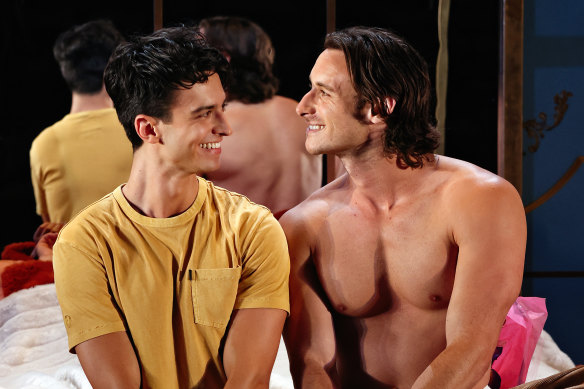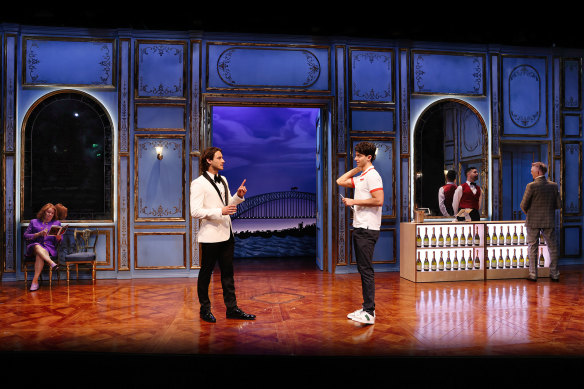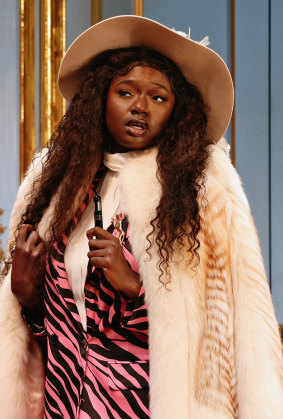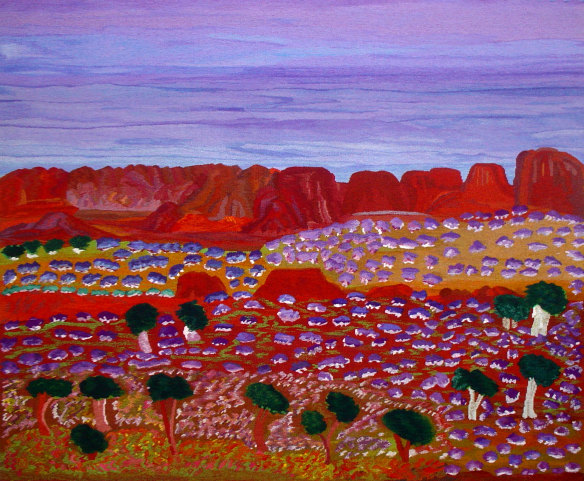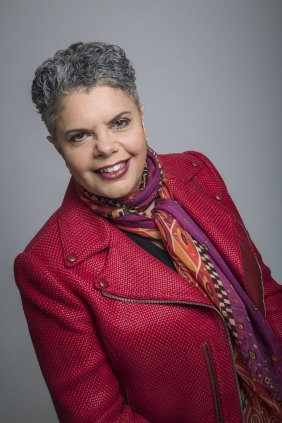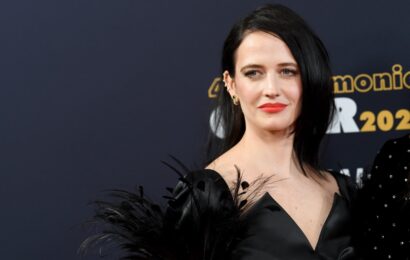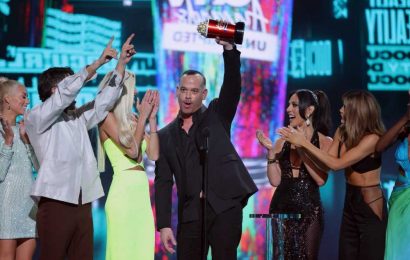THEATRE
HUBRIS & HUMILIATION
★★★½
Wharf 1 Theatre, January 25. Until March 4.
It’s as frothy as a full-cream cappuccino and as bright as a pink balloon. Imagine Kath & Kim written by Jane Austen with queer protagonists, and you’re touching on Lewis Treston’s first play for Sydney Theatre Company. It lovingly borrows from and lampoons Austen’s slow-motion love stories, while simultaneously satirising and revering bogan and camp stereotypes. If you could bottle this play and shake it up, you’d be drenched in spray rather than liquid, and yet, to mix my metaphors as shockingly as some Treston character, it has a heart of gold that runs surprisingly deep.
Roman Delo is Elliott Delaney, an ingenue who knows he’s gay, but is confused about whom he fancies, and what to do about it. Then again, he’s short on useful role models in this area. Neither his mother, the Kath-like Bernice (Celia Ireland), nor his sister Paige (Melissa Kahraman) have a strong history of knowing their own sexual preferences, and everyone else he encounters seems to have an agenda lying outside the ridiculously old-fashioned ideal of love.
Roman Delo as Elliott Delaney and Ryan Panizza as voracious opera director William in Hubris & Humiliation.Credit:Prudence Upton
Bernice needs her kids to dig her out of a financial hole, and so Elliott leaves Brisbane to “marry the richest, gayest man in Sydney”, and to forget someone he thought he loved. Once in the Emerald City, he lobs with his wealthy, harbourside-dwelling Uncle Roland (Andrew McFarlane), and starts to meet a wider gamut of humanity. In a fruity piece of dramatic irony, he’s suspicious as to why men such as the voracious opera director William (Ryan Panizza) desire him, and we’re in on the secret.
Dean Bryant directs it with a flair for shaking up the fizzy bottle, for sight gags, and for marshalling rampant hamming in the cause of broad humour and ribald entertainment. When the play is at its best, it’s really very funny, with a wit that doesn’t just evoke Austen, but also Noel Coward and even Oscar Wilde.
It’s no accident that this is diluted with inanity: Treston must like his comedy that way. Alas, it can wear so thin as to be transparent, and time can then drag, rather than speed up, as it should.
Sydney Harbourside scenes in STC’s HUbris & Humiliation.Credit:Prudence Upton
The trick for the actors is to find some semblance of truth in their zany caricatures; a truth that thickens the brew, and lets us believe them and care about them. In this regard, Andrew McFarlane steals the show.
Just as there’s a tint of mauve in his grey hair, there’s a tinge of sadness about this world-weary, arts-loving, silk-robe-wearing, ageing homosexual. For all his wealth and battalion of friends, he’s lonely. As well as funny.
Treston also spikes moments among his other characters with poignancy. He could have done it more because that sudden switch from a bawdy giggle to a lump in the throat rejuvenates our capacity to laugh, as well as enriches the experience.
Newcomer Henrietta Enyonam Amevor.Credit:Prudence Upton.
Nonetheless, Bryant has cast the piece well, using multiple STC newcomers. Henrietta Enyonam Amevor, Mathew Cooper and those previously mentioned all have their share of fun, while Isabel Hudson’s set and costumes delight in Austen-era references and a fondly kitsch Sydney Harbour backdrop.
Amid it all, Treston explores concepts of love with considerable shrewdness. Paige says of her relationship with Juki (Amevor), “we’re chemically dependent on each other”, and yet their affair is fleeting. Whereas when Elliott finds what he’s looking for, it’s more than just sexual attraction. Let me give the last word to Bernice: “Life is a humiliating experience for everyone.” Amen.
John Shand
CLASSICAL MUSIC
WOVEN SONG
★★★½
Sydney Festival. Short Black Opera. City Recital Hall.
January 25.
Woven Song by singer, lyricist and composer Deborah Cheetham is a song cycle, a weaving together of the arts and, more broadly, a metaphor for the coming together of peoples, and the yearning for an untorn social fabric.
Lumpu Lumpu Country, 2004, by Daisy Andrews was the backdrop for this Sydney Festival performance.Credit:Australian Tapestry Workshop
Serving as a projected backdrop, five of the songs had magnificent works by First Nations artists from the Embassy Tapestry Collection woven in the Australian Tapestry Workshop in Melbourne and now displayed in embassies in Singapore, Paris, Dublin, Beijing and Tokyo.
These were creations of breathtaking scale, sweep and colour to which Cheetham’s music brought textures of lofty calm enlivened by magpie-like flourishes and fleeting wisps of colour.
They were played with beautiful delicacy by Sydney and Melbourne Symphony Orchestra players, members of the Aboriginal and Torres Strait Islander chamber ensemble Ensemble Dutala led by violist Aaron Wyatt and a group of One Day in January scholars.
Deborah Cheetham stars in Woven Song.Credit:Frank Farrugia
The one day in January is, of course, January 25, 1788, seen by many as the last day of Indigenous self-determination – at least so far.
The introductory piece, Long Time Living Here (or Tarimi Nulay in the Gadigal language), for soprano, vocal quartet and ensemble was offered as an acknowledgement of country, while the Indigenous Elder who was to open the show battled Pitt St traffic.
Catching Breath was played against Brook Andrew’s recreation in tapestry of a 1900 photo of an unknown warrior.
Cheetham sang the words ‘My name!’ with urgent declamation, while a quintet of piano and strings interpolated gentler interludes.
The artwork for Above Knowing was Creek Bed, a beautifully undulating study of pink and ochre rocks and water by Elizabeth Marks Nakamarra now in the Australian embassy in Paris.
Cheetham’s song, however, explored the darker side of that Paris site as the Velodrome d’Hiver (or Vel’ d’Hiv), the round-up point for French Jews taken to Auschwitz in 1942, making a link with the round-up and chaining of Australian Indigenous people.
Gulaga, beautifully played by flautist Joshua Batty, oboist Diana Doherty, and clarinettist Alexander Morris, was a meditation of thoughtful arabesques like birds over still water.
Patrick Mung Mung’s Ngarrgooroon captures earthy natural pigments in bold contrast, while Cheetham’s music began with a flute solo, drifting like thoughts on a pleasant, still afternoon.
Pedro Wonaeamirri’s Pukumani wove rich patterns from body paint designs. Reflecting its current location in Beijing, Cheetham’s score uses a Chinese Guzheng, with a darkly swirling cadenza bowed and plucked by Mindy Meng Wang.
In the final song, My Mother’s Country, against a vividly colourful, magisterial painting, Lumpu Lumpu Country by Daisy Andrews, Cheetham’s score, with Japanese Shakuhachi, evoked stillness, disturbed by small flurries and sudden gusts, and suddenly opening into unexpected moments of intensity and elation.
As Australia contemplates a political Voice, this program wove diverse artistic voices into a richly textured fabric.
Peter McCallum
A cultural guide to going out and loving your city. Sign up to our Culture Fix newsletter here.
Most Viewed in Culture
From our partners
Source: Read Full Article
